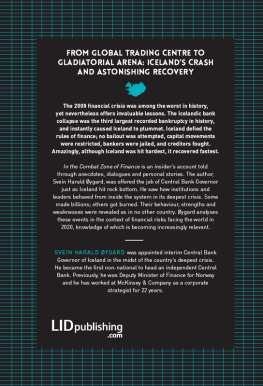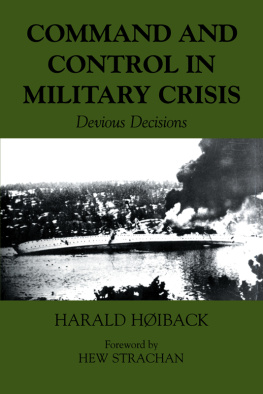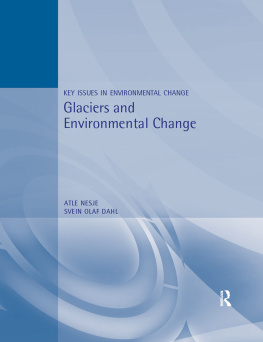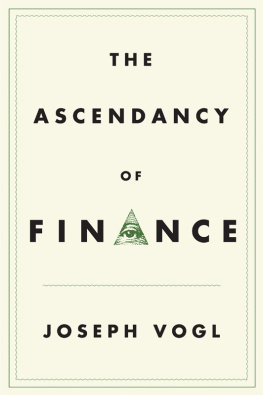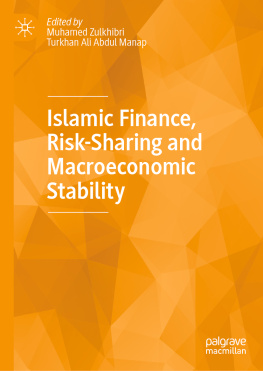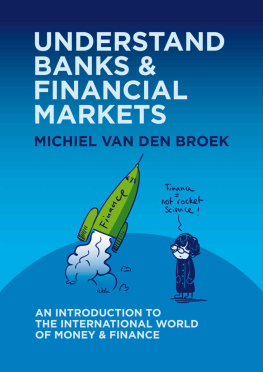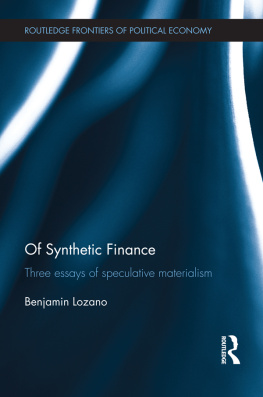Svein Øygard Harald - In The Combat Zone of Finance: An insider’s account of the financial crisis
Here you can read online Svein Øygard Harald - In The Combat Zone of Finance: An insider’s account of the financial crisis full text of the book (entire story) in english for free. Download pdf and epub, get meaning, cover and reviews about this ebook. year: 2019, publisher: LID Publishing, genre: Romance novel. Description of the work, (preface) as well as reviews are available. Best literature library LitArk.com created for fans of good reading and offers a wide selection of genres:
Romance novel
Science fiction
Adventure
Detective
Science
History
Home and family
Prose
Art
Politics
Computer
Non-fiction
Religion
Business
Children
Humor
Choose a favorite category and find really read worthwhile books. Enjoy immersion in the world of imagination, feel the emotions of the characters or learn something new for yourself, make an fascinating discovery.
- Book:In The Combat Zone of Finance: An insider’s account of the financial crisis
- Author:
- Publisher:LID Publishing
- Genre:
- Year:2019
- Rating:4 / 5
- Favourites:Add to favourites
- Your mark:
- 80
- 1
- 2
- 3
- 4
- 5
In The Combat Zone of Finance: An insider’s account of the financial crisis: summary, description and annotation
We offer to read an annotation, description, summary or preface (depends on what the author of the book "In The Combat Zone of Finance: An insider’s account of the financial crisis" wrote himself). If you haven't found the necessary information about the book — write in the comments, we will try to find it.
In The Combat Zone of Finance: An insider’s account of the financial crisis — read online for free the complete book (whole text) full work
Below is the text of the book, divided by pages. System saving the place of the last page read, allows you to conveniently read the book "In The Combat Zone of Finance: An insider’s account of the financial crisis" online for free, without having to search again every time where you left off. Put a bookmark, and you can go to the page where you finished reading at any time.
Font size:
Interval:
Bookmark:
I was fortunate to have a front-row seat as many of the events in this book unfolded. I have drawn on that experience. In addition, I conducted more than 90 interviews as part of my research.
Interviewees include former and current senior employees of financial market regulators, Ministries of Finance, Central Banks (governors, economists, market operations specialists, head legal counsel), Icelandic and international banks, members of government, business leaders, IMF employees, bank executives, credit and macro analysts, journalists, historians, investigators, members of grass-roots movements, lawyers, participants in the winding-up processes of the fallen banks and hedge fund managers. A list of the interviewees is included in the appendix. A handful requested anonymity.
There is no doubt that personalities, alliances and individual grievances have a bearing on policy decisions and the way policies unfold. Many are those that ideally should have been honoured, and some who could have been criticized by name. But this has not been the purpose of my book. Instead, my goal has been to describe the larger forces that converged on one small country in the first decade of this century, and the insights their impact provide on the world we live in and on what the future may bring. I believe that Iceland, in some sense, was a microcosm for much of what unfolded elsewhere and that its experience can help us to understand the strengths, vulnerabilities and policy options as we encounter new shocks.
With that goal in mind, I have deliberately omitted the names of most individuals involved and even those quoted, except in cases where the origin of the statements is of particular importance. The book does not attempt to describe the positions, decisions and actions of specific individuals, governments or parties. Similarly, descriptions of the goals and opinions of individuals has been kept to a minimum, reflecting the view that a government minister, an official or a business leader needs to stand behind the policies pursued and actions taken, or step down.
This book largely builds on the work of Icelands Special Investigative Committee, or SIC, with regard to the period before mid-October 2008. The SIC was appointed by the Icelandic Parliament and charged with uncovering the root causes of the countrys banking collapse. The SIC interrogated more than 120 people. It has not been my ambition to redo or question the report of the SIC and, for the most part, I did not re-interview SIC sources.
The mandate of the SIC, however, was largely focused on what happened in Iceland and less on the other side, i.e. the observations and views from abroad. I therefore made a deliberate effort to interview some of those who had key roles internationally. In addition, the SIC collected valuable perspectives from people close to the events immediately after they occurred. Many of the interviews for this book covered the same events, but obviously informed by a decade of hindsight.
As word started to circulate in Iceland that I was preparing a book, many have reached out to me with suggestions for areas of research and other ideas. I also received a wealth of documents and data, both on a solicited and unsolicited basis.
Im grateful to all of those who shared their time, their ideas, and their research materials. They have made this book immeasurably richer. The author, however, bears full responsibility for all statements of fact and judgments made. No institutions or individuals have endorsed this book or any of its elements. I apologize for any errors made or credits omitted.
A dozen individuals, Icelandic and non-Icelandic, have read the text and suggested improvements. Some have spent a lot of time searching through their files to help with additional information and clarifications. Almost all the ones I wanted to interview made themselves available, they spoke openly, and they set almost no conditions. Joachim Huse has provided analytical support, including analysing the lists of creditors. For all this, I owe a lot of thanks.
Up to 26 February 2009, the Central Bank had three governors. When the term governor is used for the period up to 26 February, it refers to the chairman of the board, unless stated otherwise. The statements attributed to the special prosecutor are from the person who held the position from 2009 onward.
Technically a bank doesnt go bankrupt but will be placed in an administrative or winding-down process. These can be run by resolution committees, winding-down boards or other bodies. For simplicity, though, I use the words bankruptcy, default and estates to characterize what happened and how it was administered.
Many descriptions are based on my own experiences. Wikipedia and other encyclopaedias have been used as a source for historical and contextual information. In particular, this applies to the chapters on Icelandic history, Some good years, and the chapters on Kiribati, on WaMu, on Pisa, Ireland and Greece.
All exchange rate figures are based on data from Icelands Central Bank, Selabanki. Figures on unemployment and macroeconomic indicators, tourist traffic, etc., are derived from Statistics Iceland.
Only sections that build on specific sources are listed. Sources used in multiple sections are listed where the topics covered are discussed at greatest depth or where they first appear. Sources already specified in the main text are not listed in this appendix. The main text indicates which statements are based on interviews. Sources for data that are easily available in the public domain, for example, data on macroeconomic measures, inflation, interest rates and market indexes, have not been listed.
The statements in this chapter are substantiated in the topic chapters.
A historic summary can be found in the Central Banks publication Iceland, the Republic, from 1996. The legislation passed on 26 February 2009 was an amendment of the Act No. 36/2001, on the Central Bank of Iceland. The provision allowing for an interim appointment was included in the Act 70/1996 on government employees.
The default ranking is from Moodys report from February 2009: Corporate Default and Recovery Rates, 1920-2008. It ranks the defaults based on default value, i.e. the value of the defaulted debt. The litigation of the 27 refers to a district court case related to SPRON.
The E24 article is from Sunday 29 March 2009 with reference to a speech at the Independence Party convention the same day. This again is based on a news report from RV, the Icelandic state broadcaster. The quote on the man from the mountain is from multiple blog entries of Hannes Hlmsteinn Gissuararson.
William McChesney Martin Jr., US Fed governor, first used the punch bowl analogy in a statement in 1955.
This chapter largely builds on information from the report of the Special Investigation Commission (SIC), in particular the summary chapter in its English translation. The information on OMX composition is from calculations based on OMX monthly statistics for March 2007. The CDO figures derive from Reuters. A Citigroup report from 3 January 2007 provides information on Kaupthings trading income, as Citigroup initiated coverage with a Buy High Risk recommendation. The FX debt figures are based on the Central Bank of Iceland Household Sector Database. The information on the banks key ratios is from
Font size:
Interval:
Bookmark:
Similar books «In The Combat Zone of Finance: An insider’s account of the financial crisis»
Look at similar books to In The Combat Zone of Finance: An insider’s account of the financial crisis. We have selected literature similar in name and meaning in the hope of providing readers with more options to find new, interesting, not yet read works.
Discussion, reviews of the book In The Combat Zone of Finance: An insider’s account of the financial crisis and just readers' own opinions. Leave your comments, write what you think about the work, its meaning or the main characters. Specify what exactly you liked and what you didn't like, and why you think so.

